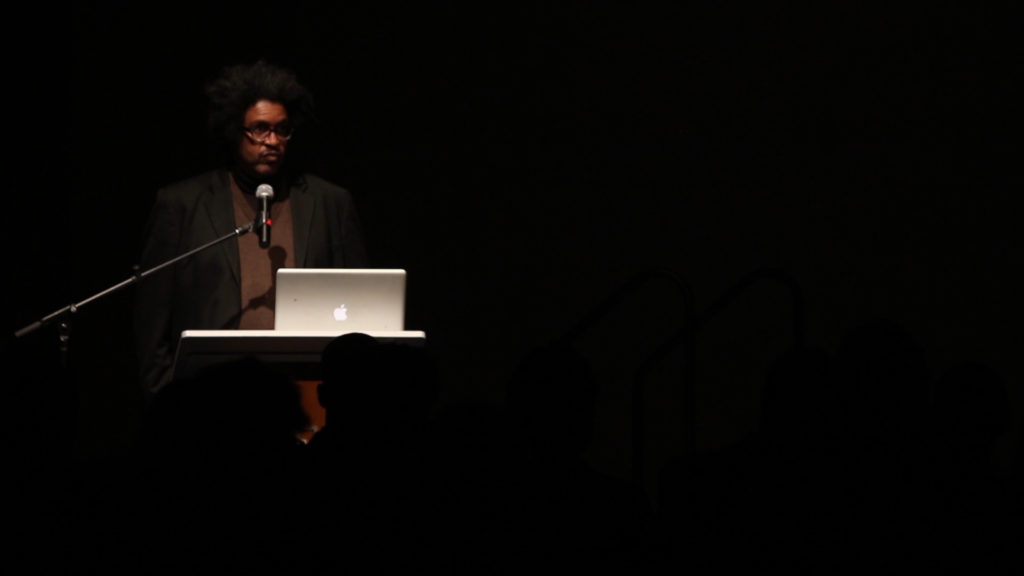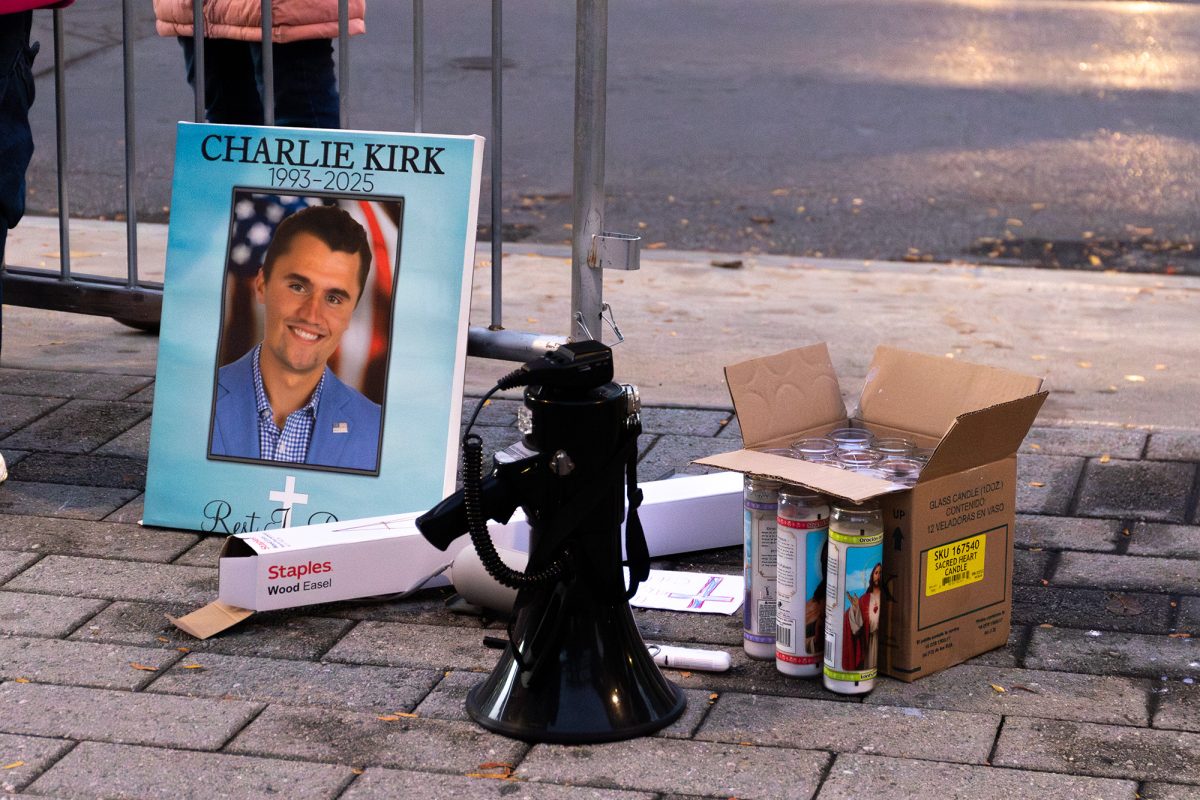In keeping with this year’s Martin Luther King Jr. Week celebration theme, “Every Step Toward the Goal of Justice,” Ithaca College encouraged the campus community to step out of its comfort zone and confront issues of race and social justice through a series of workshops and presentations.
The college held its 12th annual MLK Campus-Wide Celebration the week of Jan. 21, commemorating what would have been King’s 90th birthday. John Sims, a civil rights activist and artist, was this year’s keynote speaker. Sims is known for his conceptual artwork that deals with political activism and identity, including projects like “Recoloration Proclamation.” This project includes flags recolored to change their original meanings and installations like “The Proper Way to Hang a Confederate Flag,” a piece in which a Confederate flag is hung in a noose, and “Burn and Bury,” a coordinated event held on Memorial Day to burn the Confederate flag.
When MLK Week was first established at the college in 2008, former president Peggy Ryan Williams declared the first day of classes, which coincides with Martin Luther King Jr. Day, to be a “day on, not off,” meaning that instead of classes, students would participate in programs and activities that encouraged thought and reflection. Although the events were scheduled to start on Jan. 21 this year, they were rescheduled due to a snowstorm that left Ithaca with over 1 foot of snow.
Even though classes officially began for the spring semester Jan. 22, members of the campus community still found time to engage with the scheduled events. At a presentation titled “Geometry of Justice: Mathart to Flagart,” which was held during the noon hour in the Emerson Suites, Sims discussed how ethnomathematics — the study of mathematics and culture — influences his artwork.
Some of his mathematical work includes “SquareRoots: A Quilted Manifesto,” which features a quilted pattern and Sims’ self-portrait, and “31415: The Pi Day Anthem.”
Sims emphasized how math can be used in a way to connect individuals in vastly different communities and allow people to think differently about certain ideas and concepts, like the Confederate flag.
“If you cannot connect in the color-symbol space, how can you connect in any other space?” he asked the crowd of approximately 25 people.
This sentiment carried on in his keynote presentation, “A Blazing Grace: Space, Time and Justice,” in the Emerson Suites, where he continued to speak about the ways his art cannot only incite a community response but also encourage the viewer to reconsider the meaning of a symbol like the Confederate flag. Approximately 75 people engaged with the showing of his artwork in a collection entitled “A Blazing Grace,” a collection of works and publications that have been in the making for 16 years.
“[The project] explores the complexity of sacred symbols, creative resistance, white supremacy and visual terrorism in the context of Confederate iconography and my own African American experience and my political art process,” Sims said. “This is a testimony in confronting a symbol, a very powerful symbol, both directly and indirectly before it was popular to do so. This is the story in search of healing and power to move forward in a land that requires perpetual redirection towards a light of justice and respect.”
Sims showed videos of negative responses to his art projects and some of his multimedia pieces referenced in his earlier session. He discussed the pain and confusion associated with the symbol of the Confederate flag.
“There is the white pain of a lost war and shifting white power and privilege,” he said. “There is also the black pain of remembering and confronting a history, an American history, a trauma, a social trauma, born from the American contradiction of slavery, segregation and human suppression.”
He talked about his role as an artist and a citizen to recognize the complexity and limits of art and politics to create social change. Sims said cross-cultural experiences and engagement, education and spiritual rituals are the driving factors to induce social change.
“While politics and art can be very important agents of social change, it is the ritual space where values and responsibilities are repeatedly shaped and reinforced and sometimes transformed into formal, collective consciousness for healing and inspiration, and when ritual as a dynamic social system goes beyond the one-time event … there is an opportunity to integrate the pains of the work into everyday life where it’s needed most,” he said.
In response to a question, “Is all art is political?” he said all art has political content because it has a conversation among the artist, the environment and history.
“If I had done ‘The Proper Way to Hang a Confederate Flag’ installation in 1853, I would have been murdered,” Sims said. “It would not have been art. Now we are in a space where it could be art. What is art in one place is not art in another place.”
Following the keynote speech, Sims led a presentation, “‘AfroDixieRemixes’: The Ithaca Responses.” “AfroDixieRemixes” is a musical project by Sims. The focus of the project is the song “Dixie,” a piece that was originally about a slave who had escaped to the North and began pining for slave life back in the South.
Sims said “The Afro-Dixie Remixes” is a way to reclaim and reimagine a song that has strong connections to slavery and the African American community. In his project, “Dixie” is reimagined in hip-hop, folk, country, gospel and several other genres. Each remix contains elements of the original “Dixie” but has been redone to include new messages and ideas. Alongside Sims, members from the Ithaca community provided interpretations of the AfroDixie songs compared to the original.
Sophomore Josephine Sepel, a first-time attendee of MLK Week, said she thought the presentation was an interesting take on art as a form of protest.
“I thought it was a cool form of protest, and I liked that he had a bunch of different examples of how he has done different things with the Confederate flag and used it in different ways to break out of its conventional use,” she said.
Other presentations throughout the day raised questions about King’s legacy and the civil rights movement today. Sean Eversley Bradwell, director of the Center for Inclusion Diversity Equity and Social Change (IDEAS), encouraged members of the campus community to think deeper about King’s movement in a workshop entitled “Was Dr. King an Ally?” held during the noon hour in Clark Lounge.
The event began with Bradwell asking the group of approximately 30 people to talk about what it means to be an ally and what the word privilege means to them.
After a brief discussion, he talked about King and his sacrifices for the civil rights movement.
“This workshop, for me, arises from me thinking about Dr. King and the ways in which we celebrate Dr. King — rightfully so — because few people are willing to give their life for a cause,” he said. “It is easy to critique somebody 50 years later, but with someone that gave their life for a cause, I need to step back and be cognizant of what I am willing to give for whatever I am fighting for.”
Bradwell spoke about aspects of King’s career he felt should be questioned when looking from a contemporary standpoint. He said King focused on areas in which he faced oppression, such as race, poverty and war, but either ignored or was part of the problem on issues of gender, sexuality and religion. He showed some of King’s statements from Ebony Magazine in which he made degrading remarks about women and the LGBTQ community.
“Was he actually an ally?” Bradwell said. “Did he fight in the same way? Much to my chagrin, oftentimes the answer is no. Much to my chagrin, the answer is often worse than no.”
Freshman Julien Sobel said he appreciates that the college is encouraging dialogue regarding issues of race.
“I think Ithaca is not always known as the most diverse school, but we are making an effort to diversify and to be more accepting and cognizant of more of what is going on,” he said.
President Shirley M. Collado echoed Bradwell’s sentiments at the beginning of the keynote presentation held in the Emerson Suites, where she spoke to approximately 120 people about the importance of intentionally facing conflict and addressing uncomfortable issues.
“Remembering the necessary struggles we all must face is an important part,” Collado said. “We talk about celebrating Dr. King’s legacy, but what would it mean to live it? To not just celebrate it and feel good about it and have a moment of reflection on a day or a week, but what does it mean to truly march toward … this goal of justice?”
The keynote began with a civil rights tour presentation from the freshman MLK Scholars about their annual fall break trip to the South.
Lining up on the stage in the dark, the 23 scholars stood while a video of King and protests of the original civil rights movement played behind them. The narrative switched from past to present as the video turned to clips of President Donald Trump, the Ku Klux Klan and police brutality against Eric Garner and Freddie Grey. The scholars then took turns sharing their perspectives on slavery and its contemporary counterparts, such as mass incarceration of people of color, police brutality, poverty and segregation as a result of societal systems.
Freshman Armani Young, one of the presenters, said the group wanted to make sure it made a presentation that was inclusive and would get the point across: that oppression has progressed rather than been eradicated.
“I think it is very unique and very good, especially for a [predominantly white institution], to have a day where we can talk about these things in an open space and not just have them hidden and pretend it’s not a thing,” she said.
Cyndy Scheibe, professor in the Department of Psychology and executive director of Project Look Sharp, also led a presentation, “Social Media, Social Justice and Media Literacy: Sports and Action,” at 7 p.m. Jan. 23 in the Emerson Suites.
The presentations held Jan. 24 will include two more lunch–hour workshops, “Unpacking Our Own Privilege” from IDEAS student leaders and “Stepping into Justice: Spirituality and Activism” presented by an interfaith leader panel in Klingenstein and Clark Lounges, respectively. An interfaith community dinner will be held from 5:30 to 8:30 p.m. in Muller Chapel.
Events held Jan. 25 will include “Songs of Resistance” from 8 a.m. to noon and 1:30 to 5 p.m. in Muller Chapel and “The People’s Movement,” a multimedia learning, viewing and reflection space, from 11 a.m. to 3 p.m. in Klingenstein and Clark Lounges. The MLK Shabbat Service will be held from 6 to 7 p.m. in Muller Chapel, followed by the annual School of Music concert in honor of King at 7:30 p.m. in Ford Hall in the James J. Whalen Center for Music.
The week will end with a day of service on Jan. 26 throughout Ithaca to engage the college community members with the greater Ithaca community.
Sims said that he appreciated the opportunity to address the college community and that the college should be commended for making these celebrations a part of the campus culture.
“It was an incredible experience to be a part of a program celebrating the legacy of Dr. Martin Luther King Jr. and the charge he gave us to continue the struggle for a more just society,” Sims said via email. “The MLK celebration events at Ithaca College is a great model of spirit and practice on how we all should use MLK Day as a space of reflection and rejuvenated commitment.”
Assistant news editors Krissy Waite and Ryan King and staff writers Elizabeth Henning and Ashley Stalnecker contributed reporting.







